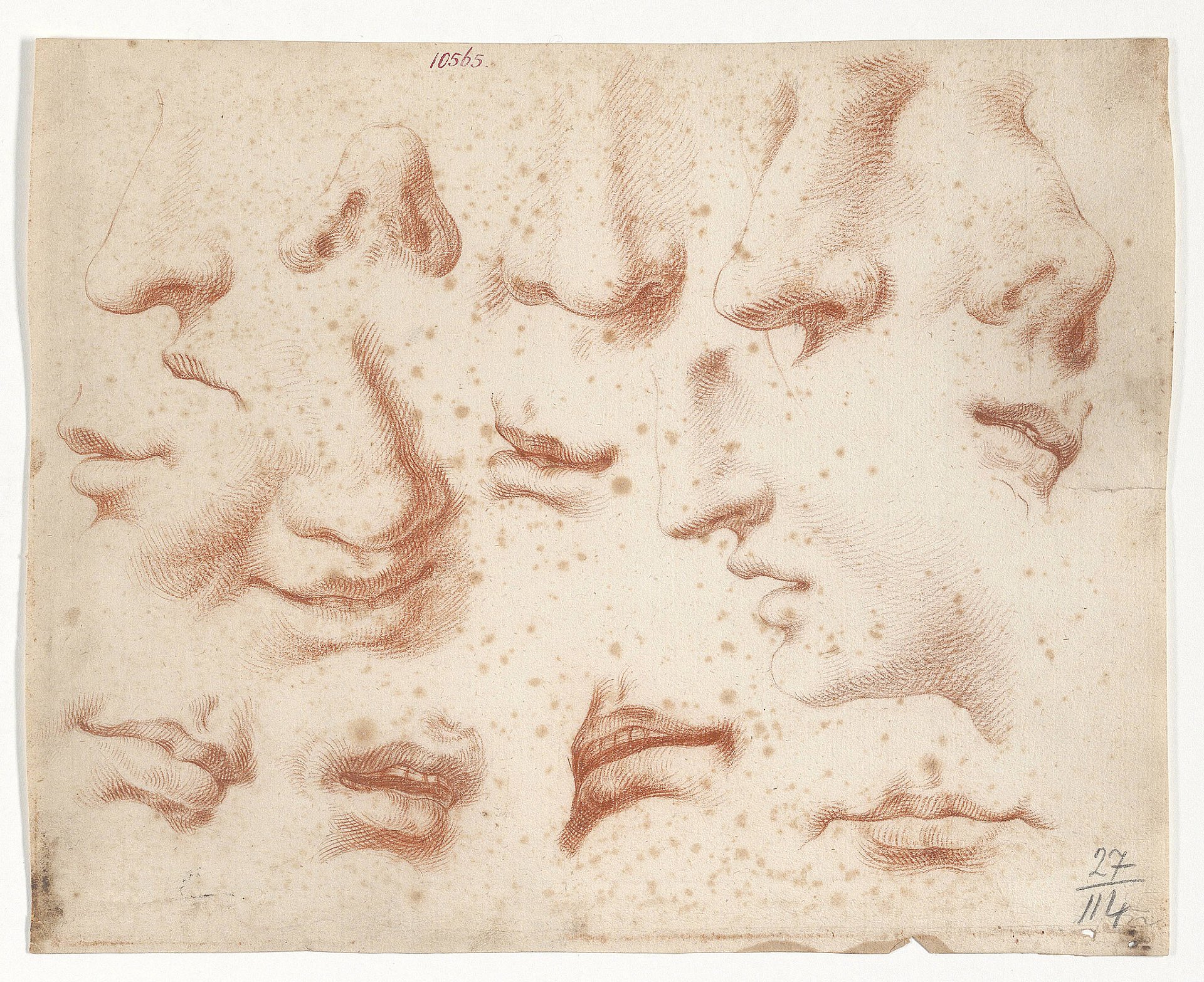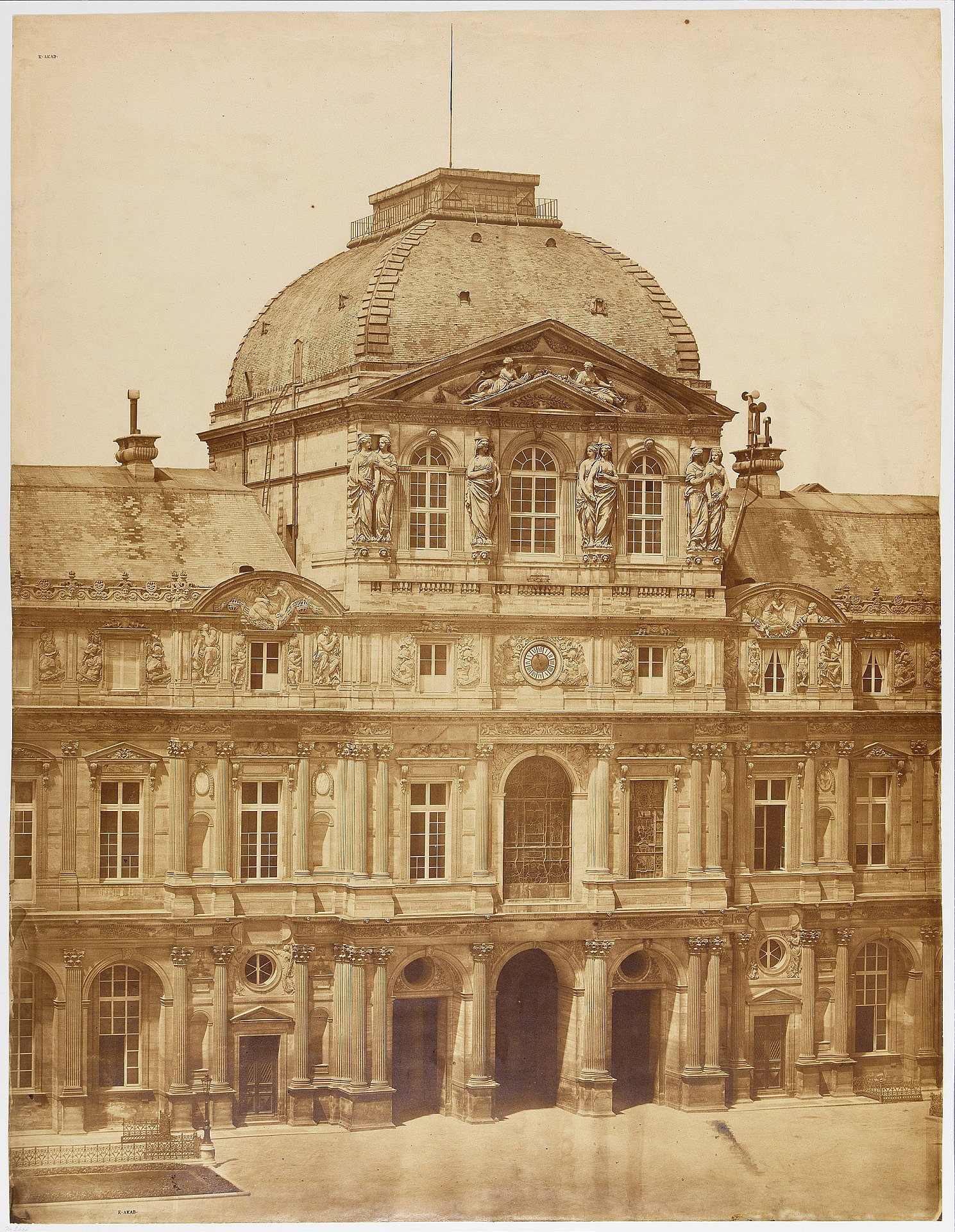History
Drawings and prints have been an integral part of the Academy of Fine Arts Vienna ever since its founding in the late 17th century. These works have been used as reference material, objects of study and sources of inspiration in lectures and for teaching purposes. An invaluable collection of such teaching materials, mainly from the 18th and early 19th centuries, has been preserved in the Graphic Collection. 
Unknown artist, Studies of the Mouth and Nose, before 1751, red chalk on paper
Following his appointment as Protektor of the Academy in 1772, State Chancellor Wenzel Anton von Kaunitz-Rietberg initiated a comprehensive reorganisation of the institution. It included merging the existing Art Academy with the Academy of Commercial Drawing (also known as the Manufactory Drawing School), the Copperplate Engravers’ Academy and the Ore Cutters’ School to form the Imperial & Royal United Academy of Fine Arts (k. k. vereinigten Akademie der bildenden Künste). As part of the reorganisation, the Academy Council resolved on 19 February 1772 to establish a separate library with an affiliated graphics collection. The existing inventories, in particular those of the Art Academy and the Engravers’ Academy, were combined, with selected books and graphics remaining in those classes where they were of particular interest. The founding charter provided for the constitution of a collection of teaching resources that might be ‘beneficial to artists [...]’. Over the decades that followed, substantial state funding paved the way for the acquisition of sizeable collections of drawings and prints. The inventory grew to include individual prize-winning works as well as reception pieces; indeed, as of 1751, Academy members were required to submit such works as evidence of their aptitude. By 1805, this collection of graphic art had grown to more than 11,000 works. 
Charles Nicolas Cochin le Jeune (sketch), Benoît-Louis Prévost (engraving), The Study of Drawing (submission work), 1763, engraving and etching
In the first half of the 19th century, the collection expanded enormously in terms of both quality and quantity under the patronage of Klemens Wenzel Lothar von Metternich, with generous donations and bequests from private individuals. These endowments often comprised several thousand sheets and included significant collections such as Gothic architectural drawings, old master drawings by Albrecht Dürer, Albrecht Altdorfer and Rembrandt Harmensz. van Rijn as well as the stage set and festive decoration designs of the Galli Bibiena family. Larger donations included the bequest of Franz de Paula Neumann from 1816, the donations of Ludwig von Remy from the period 1838 to 1840, the donation of Prince Rudolf von Colloredo-Mansfeld from 1838 and the bequests of Franz Jäger jun. in 1839 and Vincenz von Eyssen in 1844. By the mid-19th century the collection had grown to over 50,000 works thanks to these private endowments and the ongoing policy of state-funded acquisitions and allocations 
Rembrandt Harmensz. van Rijn, Landscape with an Inn and Farmhouses under Trees, c. 1660, iron gall ink on paper
In the second half of the century, the unwritten mission statement governing the collection of prints and graphic arts gradually broadened its remit. Hitherto, the focus had been on teaching materials, but now new acquisitions were guided by considerations pertaining to art history and the collection itself. This shift in emphasis was evident already during the tenure of the librarian and curator of the graphic arts collection, Johann Trost, with for instance the 1850 purchase of flower watercolours by Moritz Michael Daffinger; it was maintained and, indeed, reinforced under his successor Carl von Lützow from 1866 onwards. This is true in particular of the selective acquisitions of the collection of Johann Christoph Endris in 1868, which essentially comprised romantic artists from southern Germany and Austria, and the Dürer print collection of Edward Jakob von Steinle in 1873. 
Julius Schnorr von Carolsfeld, Christ’s Parable of the Tares, 1816, pen and brush in black and brown, preliminary pencil drawing, on paper
It was around this time that the library began to establish a collection of photographic prints. The first such prints were donated in the summer of 1854. November 1855 saw the first selective purchase by Eduard van der Nüll, professor of architecture, at the Paris studio of the photographers Bisson Frères. Thereafter, the Academy was regularly supplied with photographic prints by book and art dealers, so much so that, by 1920, it had accumulated some 15,000 prints, thanks also to a number of private donations. They represent the mainstay of today’s photography collection in the Graphic Collection. 
Bisson Frères, Pavilion of the Louvre Clock in Paris, 1854, salt print
The duality of a collection of teaching resources and a collection of prints and drawings based on art historical considerations was retained in the 20th century. The collection therefore mainly contains works by artists associated with the Academy, whether as students, teachers or in some other capacity. They include, for example, the archives and numerous drawings of the Hagengesellschaft artists’ association, a large collection of design drawings by Otto Wagner and the estate of the architect Ernst Anton Plischke. In 1997, the then director of the Kupferstichkabinett, Monika Knofler, initiated the now annual purchase of contemporary art in a bid to fulfil the Academy’s visual memory remit, focusing in particular on the Academy’s own graduates. 
Otto Wagner, Design for the Antechamber Bunk in the Apartment of Otto Wagner at Köstlergasse 3, 1898, Indian ink and watercolour, preliminary pencil drawing, on paper
In 2004, the Graphic Collection was separated from the library as the 2002 University Act came into force and instituted as a discrete department. Since 2016, it has been under the joint management of the Paintings Gallery and the Plaster Cast Collection. In 2021, these three collections were consolidated on the shared premises of the Art Collections (Kunstsammlungen) of the Academy of Fine Arts Vienna.